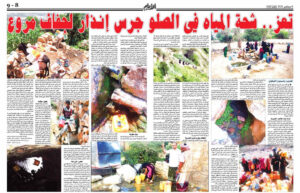The annual average number of people who have left their homes since 2008 for reasons related to the effects of climate change and environmental degradation is about 21.5 million, according to the United Nations High Commissioner for Refugees, as a result of sea level rise, erosion, floods, storms and forest fires. Many communities migrate due to loss of livelihoods, food insecurity, and/or lack of access to health care – some by choice, but others are forced to leave their homes without any means. With this statistic, an advice paper entitled “People on the Move: Reporting on Migration, Mobility and Displacement in the Age of Climate Change“, which is the result of cooperation between the Internews Foundation and the Earth Journalism Network, and includes useful definitions, information, advice and important resources on preparing press reports on climate migration. We share with you the most prominent highlights of it and you can refer to the full text through this Link.
Climate migration: This term is used to define migrants who leave their homes due to the effects of climate change, and it is not a new process, while the term has become more commonly used in the past few years.
Throughout this paper, you will find many definitions related to the migration process, such as mobility, migration, displacement, internal displacement, migration due to climate change, and the nuances between each of them.
The tip sheet also provides a set of tips for preparing press reports, such as:
-It is necessary to ask some questions while investigating migration stories in local communities, such as: Who moves and who stays? What are the disparities in the migration of the rich and the poor? Answering these questions helps inform reporting through an environmental justice lens.
- Global numbers on migration are useful for journalists looking to present a big picture on a very complex issue - but these numbers do not take into account these diverse types of migration and their social, cultural, economic and environmental impacts, which is what the journalist should pay attention to.
The paper reviews examples of migration that illustrate the specificity of some local communities, including:
• In communities in the Sundarbans region of Bangladesh, residents are regularly evacuated to storm shelters. But they are returning to their destroyed homes, damaged fishing boats and salty farmland unsuitable for agriculture.
• Without a home or source of livelihood, they are subject to permanent displacement.
• In Louisiana's Mississippi River Delta communities, residents who choose to leave move to two or three towns along the highway, while residents who do not have the resources to move face a lack of social services due to population decline.
• In Kenya, pastoralist communities maintain herds with drought-tolerant and mobile livestock species as a drought adaptation mechanism. However, as climate change accelerates, pastoralists are migrating to urban centers and becoming embroiled in conflicts with farming communities.
• In Latin American countries such as Panama, Nicaragua, Bolivia, Peru and Ecuador, migrant workers travel during the harvest season to other countries including Argentina and Costa Rica.
However, these workers often face health risks and other exploitative labor practices, and the sector is also vulnerable as climate change alters crop growing seasons and the availability of fresh water.
• -Understanding the data on displacement, future predictions, and the causes of displacement that are not necessarily attributable to climate change but may result from natural disasters, realizing the nuances between them, and using data to tell the story, starting from the question: What story does the data tell about your country or region?
• -Looking at migration as one of the climate solutions for adapting to climate change and how journalists can hold decision-makers accountable in their countries. What do these solutions look like, and are these solutions being implemented in an effective, robust, and evidence-based way? Are there guarantees to prevent, delay and/or make migration more equitable?
• - Avoid gaps in reporting by relying on accurate data to tell the story and avoiding exaggerations and sensationalist headlines that are not supported by the data.
• The paper presented some topics that can be addressed while working on climate migration stories, which are:
Here are some examples of topics to explore when reporting on climate migration:
• Government plans: What types of plans has your government developed for coastal communities?
Find government plans or guidelines on disaster management and risk reduction, planned resettlement, community input and stakeholder engagement, land planning, development permits and more.
• The relationship between climate change, migration and trafficking: How does climate change make forced displacement more urgent than ever?
What risks do women, girls and other marginalized communities face when migrating, such as trafficking and exploitation?
Is your government aware of these risks and what plans are in place to protect vulnerable people?
• Slow-onset versus fast-onset events: Are there slow-onset events, such as sea level rise, saltwater intrusion, or drought, that are underreported or not noticed by policymakers in your area? How do you draw attention to the often overlooked impacts of climate change?
• Legal frameworks: How can international, national, regional and local laws better protect migrants of all types?
Could the Refugee Convention be amended to include climate change as a valid reason for seeking asylum or refugee status?
How does your country view migrants generally, and are there ways those seeking to move can do so safely?
What legal protections do immigrants have in the workplace, for example, and how can they access health care?
• Portable social safety nets: What social safety nets are available to migrants in your country?
What type of immigration status do they need in order to access these safety nets, and are resources available for those who may not speak the national language?
What type of safety net – cash assistance, insurance plans, subsidies, etc. – would be most beneficial to communities in your area?
• Land rights: Many communities will choose not to evacuate during disaster events because they lack property rights and worry that their homes will not be theirs when they return.
How can new frameworks be developed that protect the ability of these communities to return to their homes while ensuring their safety during storms?
The paper also included a number of important resources, such as data sources on climate migration and good journalistic examples from which to draw inspiration. Here are some of these resources:
Examples of good stories about climate migration:
The real story behind climate gentrification in Miami
What can women who stay tell us about migration?
Data sources:
Global Migration Data Portal from the International Organization for Migration
Refugee population statistics database from the United Nations High Commissioner for Refugees
Global Internal Displacement Database from the Internal Displacement Monitoring Centre
This newsletter was produced by Hannah Bernstein with input from Amrita Gupta and Caroline Rothery.





